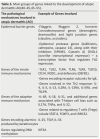The primary mechanisms underlying atopic dermatitis
- PMID: 39812196
- PMCID: PMC11906244
- DOI: 10.62438/tunismed.v103i1.5220
The primary mechanisms underlying atopic dermatitis
Abstract
Introduction: Atopic dermatitis (AD) is a complex skin disease frequently linked with other atopic symptoms such allergic rhinitis and asthma. The disease's history consists of persistent relapses with extreme pruritus, which lowers quality of life. AD has become a global health concern as its incidence has increased over the last few decades. It ranks as the third most common dermatologic disorder.
Aim: There are several open questions about the mechanisms underlying atopic dermatitis (AD), This review aims to emphasize the recent advances in scientific research regarding the pathophysiologic mechanism of AD and the clinical application of these factors.
Methods: A PubMed search was performed using the keywords "Atopic Dermatitis (AD)", "epidemiology", "clinical presentation", "diagnosis", "pathophysiology", "genetic defect", "impaired skin barrier", "immune dysregulation". The search strategy included meta-analyses, clinical trial, observational studies, and reviews.
Results: Atopic dermatitis affects over 2 million children worldwide, with a lifetime incidence of up to 20%. New data suggest that its incidence is still growing, particularly in low-income nations. AD is diagnosed clinically using the patient's medical history, particular clinical symptoms, and the elimination of other non-inflammatory skin conditions. The pathogenesis of AD is extremely complicated and involves several etiologies, including genetics, the microbiome, abnormalities in the skin barrier, along with dysfunctional innate and adaptive immune systems.
Conclusion: Recent research has improved our understanding of disease pathophysiology in atopic dermatitis. Current and future clinical trials are expected to continue clarifying this complex and heterogeneous skin disease, and to develop medications that promise more effective therapy, particularly for individuals with limited response to conventional treatments.
Keywords: Atopic Dermatitis (AD); clinical presentation; diagnosis; genetic; pathophysiology; treatment.
Figures






References
-
- Mandlik DS, Mandlik SK. Atopic dermatitis: new insight into the etiology, pathogenesis, diagnosis and novel treatment strategies. Immunopharmacol Immunotoxicol. 2021;43(2):105–125. - PubMed
-
- Torres T, Ferreira EO, Gonçalo M, Mendes-Bastos P, Selores M, Filipe P. Update on Atopic Dermatitis. Acta Médica Port. 2019;32(9):606–613. - PubMed
-
- Kaufman BP, Guttman-Yassky E, Alexis AF. Atopic dermatitis in diverse racial and ethnic groups—Variations in epidemiology, genetics, clinical presentation and treatment. Exp Dermatol. 2018;27(4):340–357. - PubMed
-
- Nutten S. Atopic Dermatitis: Global Epidemiology and Risk Factors. Ann Nutr Metab. 2015;66(Suppl. 1):8–16. - PubMed
Publication types
MeSH terms
LinkOut - more resources
Full Text Sources
